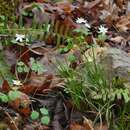Description
provided by eFloras
Plants densely cespitose; rhizomes ascending to erect, reddish brown, 0–10 mm, stout. Culms 8–27 cm, scabrous distally; bases (remnants of old leaves) strongly fibrous. Leaf blades green, greatly exceeding culms, 1.4–4 mm wide, herbaceous, papillose to scabrous abaxially, papillose to scabrous adaxially. Inflorescences with both staminate and pistillate spikes; peduncles of staminate spikes 0.3–0.8 mm; proximal cauline bracts leaflike, usually shorter than inflorescences. Spikes: proximal pistillate spikes 2–3 (basal spikes 0); cauline spikes overlapping, proximal 2 separated by less than 7 mm, with 6–15 perigynia; staminate spikes 5.3–10 × 1.1–2.3 mm. Scales: pistillate scales pale to, usually, dark reddish brown to purplish brown, with similarly colored or narrow white margins, ovate to lanceolate, 2.9–3.7 × 1.2–2 mm, equaling or exceeding perigynia, apex acute to acuminate or cuspidate; staminate scales ovate, 3–4.3 × 1–1.8 mm, apex obtuse to acute or acuminate. Anthers 1.4–2.6 mm. Perigynia pale green, veinless, ellipsoid, 2.8–3.6 × 1–1.3 mm, longer than wide; beak straight, pale green, 0.7–1 mm, weakly ciliate-serrulate, apical teeth 0.1–0.4 mm. Stigmas 3. Achenes brown, ellipsoid, obtusely trigonous in cross section, 1.4–2 × 0.9–1.2 mm. 2n = 36.
- license
- cc-by-nc-sa-3.0
- copyright
- Missouri Botanical Garden, 4344 Shaw Boulevard, St. Louis, MO, 63110 USA
Distribution
provided by eFloras
Ont.; Ala., Ark., Conn., Del., D.C., Ga., Ill., Ind., Ky., Mass., Miss., Mo., N.J., N.Y., N.C., Ohio, Pa., R.I., S.C., Tenn., Va., W.Va.
- license
- cc-by-nc-sa-3.0
- copyright
- Missouri Botanical Garden, 4344 Shaw Boulevard, St. Louis, MO, 63110 USA
Habitat
provided by eFloras
Acidic soils of rocky, dry woods, thickets, and clearings, in partial shade of mixed hardwood-pine forests or full sun along open roadsides and clearing edges, often adjacent to streams; 10–800m.
- license
- cc-by-nc-sa-3.0
- copyright
- Missouri Botanical Garden, 4344 Shaw Boulevard, St. Louis, MO, 63110 USA
Comprehensive Description
provided by North American Flora
Carex nigromarginata Schw. Ann. Lye. N. Y. 1: 68. 1824
Carex lucorum var. nigromarginata Chapm. Fl. S. U. S. 539. 1860. (Based on C. nigromarginata Schw.)
Cespitose and short-stoloniferous, the rootstocks slender, scaly, the stolons short, ascending, the culms 2-10 cm. high, much exceeded by the leaves, triangular, rough on the angles, dark-reddish-purple and strongly fibrillose at base, the basal leaves very long, the culms central, unequal in length, several together, the sterile shoots lateral, elongate, reddishpurple at base, the sheaths breaking and becoming filamentose; basal leaves very long and conspicuous, the blades 1.5-4 dm. long, 2-4 mm. (rarely 1 mm.) wide, flat or channeled at base, green, rather stiff, very rough, those of the fertile culms shorter, often much reduced, the sheaths truncate at mouth, the ligule short; staminate spike solitary, sessile, 5-8 mm. long, 1.5-2 mm. wide, the scales obovate, short-cuspidate to obtusish, purplish-brown with greenish midrib and narrow hyaline margin; pistillate spikes 2 or 3, sessile, erect, contiguous or the lower slightly separate, the upper at the base of the sessile staminate spike, orbicular or ovoid-orbicular, 4-7 mm. long, 3-5 mm. wide, closely flowered, with about 6-15 ascending perigynia; basal spikes absent; bract of lower spike well-developed, squamiform, sheathless, green, enlarged and hyaline at base, attenuate, 5-25 mm. long, and from shorter than to exceeding the inflorescence, 1.5 mm. wide at base, the upper bracts similar but shorter; scales oblong-ovate or ovate, short-cuspidate to acutish, wider than and from slightly shorter to slightly longer than and largely concealing the perigynia, with a broad light-colored center and usually strongly dark-purplish margin, the edges narrowly white-hyaline, or at times in undeveloped specimens the margin narrow and inconspicuous; perigynia oblong-obovoid, 3-4 mm. long, the body oval, 1.75-2 mm. long, 1.5 mm. wide, somewhat compressed, obtusely triangular in cross-section, sparsely short-pubescent, 2-ridged, otherwise nerveless, membranaceous, dull-green or yellowish-green, completely filled by achene, strongly stipitate, tapering into a spongy base, 0.75 mm. long, abruptly contracted into a beak 1 mm. long, slender, shallowly bidentate, hyaline at the orifice; achenes triangular with slightly convex sides and narrow angles, oval, 1.5 mm. long, 1 mm. thick, brown, abruptly substipitate, abruptly minutely apiculate; style very short, slightly enlarged at base, jointed with achene, deciduous; stigmas three, slender, reddish-brown.
Type locality: "Carol."
Distribution: Dry woods, acid soils, Florida to Louisiana, and northward to southeastern Missouri. Tennessee, and Connecticut. (Specimens examined from Connecticut, New York, New Jersey, Pennsylvania, Delaware, Maryland, District of Columbia, Virginia. North Carolina, South Carolina, Georgia, Florida, Alabama, Mississippi, Louisiana, Arkansas, Tennessee, southeastern Missouri.)
- bibliographic citation
- Kenneth Kent Mackenzie. 1935. (POALES); CYPERACEAE; CARICEAE. North American flora. vol 18(4). New York Botanical Garden, New York, NY
Carex nigromarginata: Brief Summary
provided by wikipedia EN
Carex nigromarginata is a North American sedge which grows on acid soils in dry woodland, thickets, and roadside, and similar ruderal habitats in partial shade or in full sun, often near streams at elevations of 10–800 m (33–2,625 ft). The plants grow in dense clumps, often forming circular patterns on forest floors or roadsides. 2n = 36.
- license
- cc-by-sa-3.0
- copyright
- Wikipedia authors and editors

